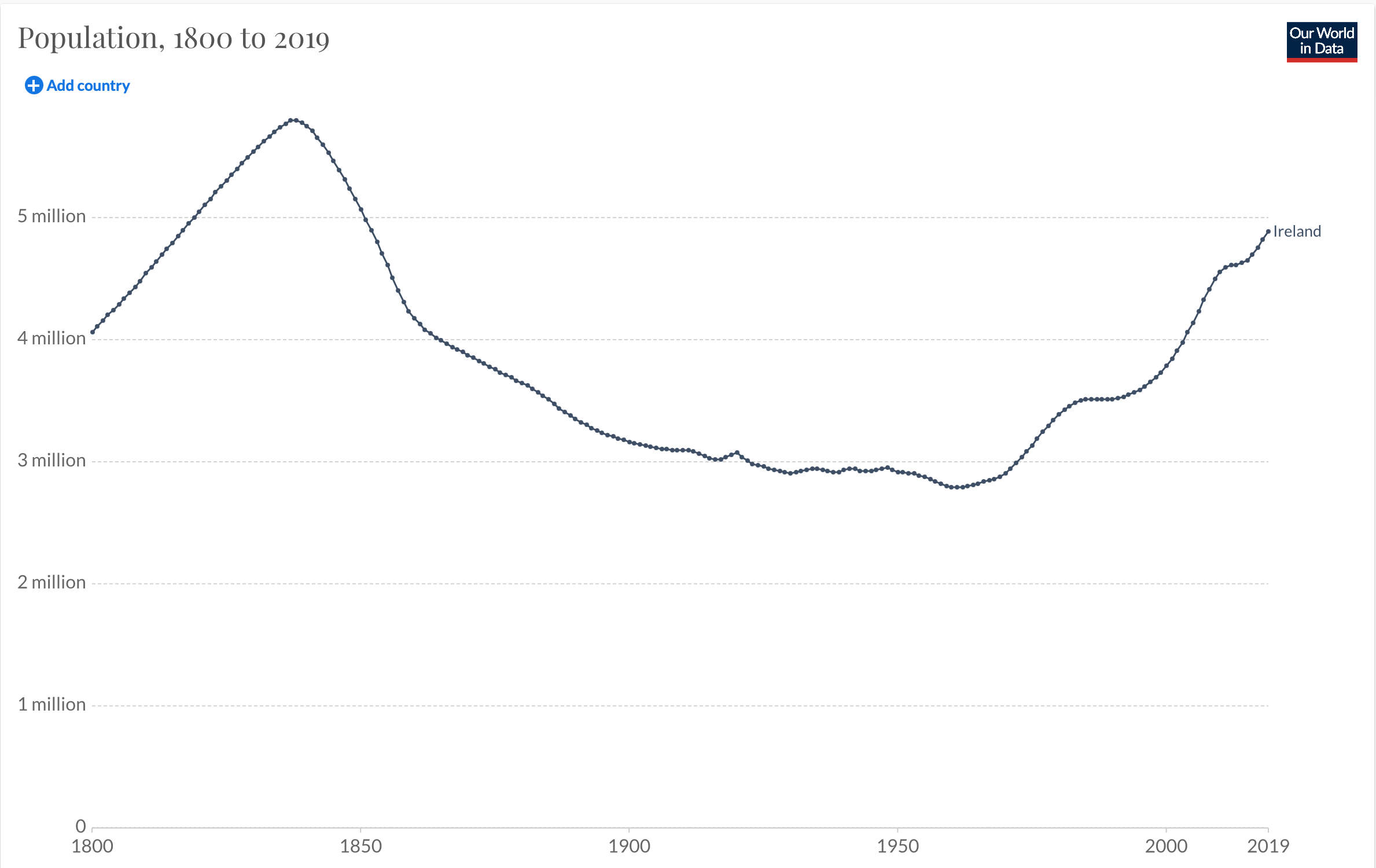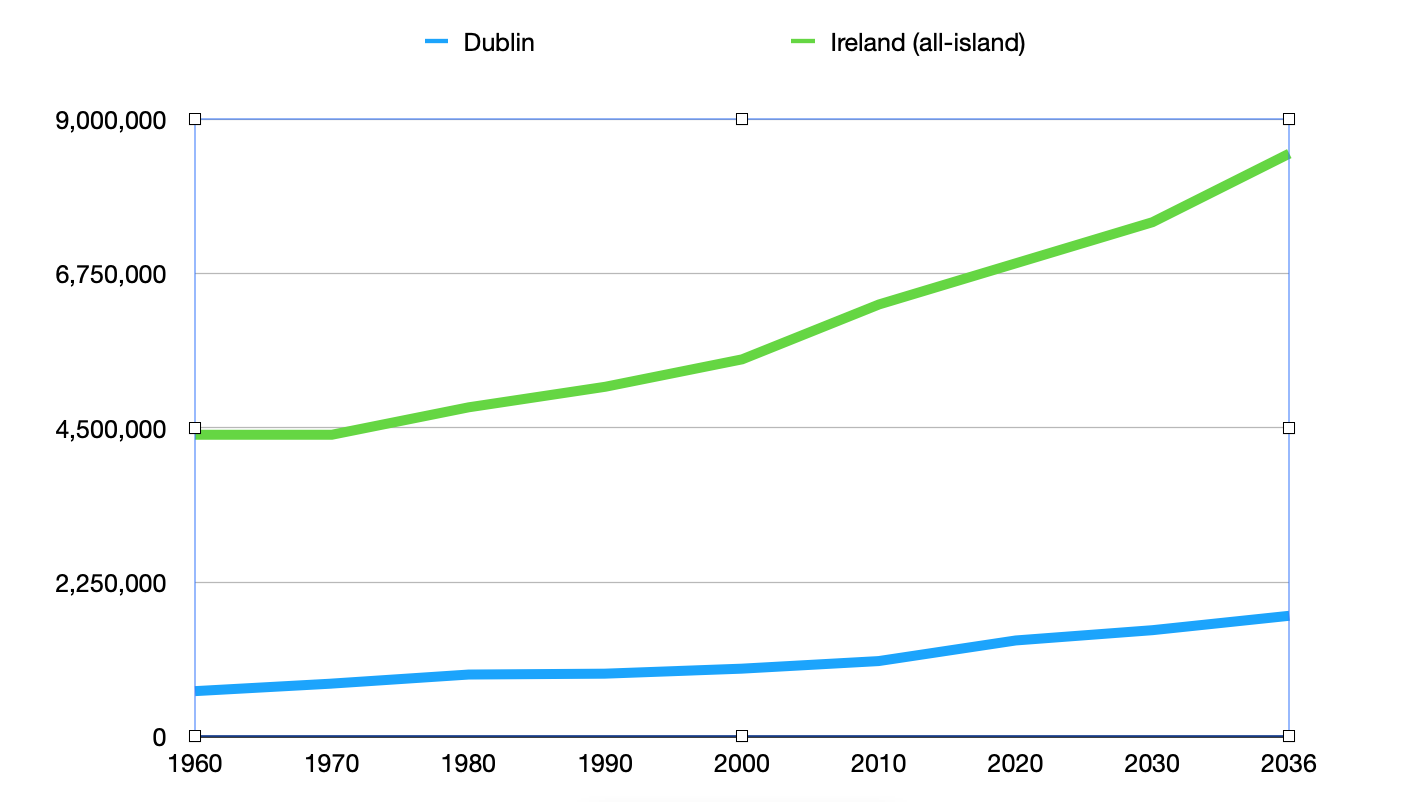Population changes: Ireland and Dublin in focus and how it impacts numbers on the outdoors
Source: OurWorldInData
Marvel at what has changed over the world:
In 1800, there were 1.0 billion people on the whole planet
In 1900, there were 1.6 billion people on the whole planet
In 2000, there were 6.2 billion people on the whole planet
In 2019, there were 7.7 billion people on the whole planet
Look at that graph right showing the trend. Those numbers are incredible, and as you’ll notice that line of growth is not slowing just yet either (we’re expected to peak somewhere around 10 billion total). What I’m trying to highlight here, is that when people got ideas to travel and explore (and we can look at easy examples like Columbus in 1492, ‘finding’ the USA), there just weren’t a lot of us around (but let’s not get into another tangent discussing the murder of the era, o.k :).
To make this relevant to the country where this post originated from, I’ll focus on just one location for this: population increases in Ireland. We all “remember the good old days” when things were smaller, simpler, quieter, right? Maybe because it was! As it happens, we have a pretty good idea of Ireland’s population back to the 1700 or so (graph to the right). But let’s make it relevant to those of us who are actually alive right now:
Source: @jlpobrien
Born in 2000, so you’re now 21? The population last year, when you were 20, was ~6.9 million
Born in 1990, so you’re now 31? The population, when you were 20, was ~6.3 million. The population is now 6.9 million (+600,000 people)
Born in 1980, so you’re now 41? The population when you were 20 was ~5.5 million. The population is now 6.9 million (+1,.4 million people)
Born in 1970, so you’re now 51? The population when you were 20 was ~5.1 million. The population is now 6.9 million (+1.8 million people)
Born in 1960, so you’re now 61? The population when you were 20 was ~4.8 million. The population is now 6.9 million (+2.1 million people)
Born in 1950, so you’re now 71? The population when you were 20 was ~4.4 million. The population is now 6.9 million (+2.5 million people)
Born in 1940, so you’re now 81? The population when you were 20 was ~4.4 million. The population is now 6.9 million (+2.5 million people)
So, in the last 70 years, there are now 2.5 million extra people on the island of Ireland. Read that again, there is now TWO AND A HALF MILLION EXTRA PEOPLE on the island in the last 70 years (a more than 50% increase in the last 70 years).
DUBLIN
Dublin population, 1960 - 2020.
Since Dublin is the main urban centre in Ireland, and as Wicklow sees some of the largest challenges with the number of users, let us look at Dublin in isolation. Since 1950, Dublin has grown annually by, on average, 1.12% from roughly 600,000 inhabitants to 1.4 million (2020) - that’s over double. Let us do the same routine:
Born in 2000, so you’re now 21? The population last year, when you were 20, was ~1.4 million
Born in 1990, so you’re now 31? The population, when you were 20, was ~1.1 million. The population is now 1.4 million (+300,000 people)
Born in 1980, so you’re now 41? The population when you were 20 was ~ 0.99 million. The population is now 1.4 million (+400,000 people)
Born in 1970, so you’re now 51? The population when you were 20 was ~.91 million. The population is now 1.4 million (+500,000 people)
Born in 1960, so you’re now 61? The population when you were 20 was ~.9 million. The population is now 1.4 million (+500,000 people)
Born in 1950, so you’re now 71? The population when you were 20 was ~.77 million. The population is now 1.4 million (+600,000 people)
Born in 1940, so you’re now 81? The population when you were 20 was ~.66 million. The population is now 1.4 million (+640,000 people)
If you watch closely, Dublin didn’t exist west of the word ‘Ballyfermot’ in the early 1980’s…. (Source: Google Earth timelapse.)
Notice how the push south onto the edge of wicklow hills also occurs.
USING MYSELF AS AN EXAMPLE: JUST ANOTHER 40-YEAR OLD
As we know kids don’t use Facebook (thankfully!), we can assume that most individuals joining in the interesting threads kicked off by Ambrose after his post are at least in their 30’s and most likely, 40 and above (for the most part).
I’m 40 so I’ll use myself as an example.
For myself, there are now 2.1 million people EXTRA in Ireland, and 500,000 extra people in Dublin since I was born.
Even if we take it from when I turned 20, there are now 1.4 million extra people, and 400,000 extra people in Dublin alone.
That is a lot of extra people on the island to show an interest in doing activities of all kinds……
People play to their own memories and biases so for many, their memory of the old days IS true - there were a lot less people around.
In short, what I’m trying to say is: even ignoring all the fancy smartphones, and the invention of social media - there’s just a lot more people in the last 60-70 years (from when it was at its lowest). And not only that, but the number of people is accelerating.
PREDICTING THE FUTURE FOR IRELAND POPULATION
Let us make sure to predict for both Dublin and the island (I’m too lazy to break it out for the Republic and Northern Ireland, sorry! Anyway, Star Trek predicted the island would be unified by 2024 - fun fact, this piece was removed when the episode was broadcast in 1990 in Ireland - how is that to stir a debate! An aside: I’ve no side/opinion in that debate - I’ve no time for that sort of discussion, we all live on the same planet).
As a reminder, in 2020, Dublin is around 1.4 million people for 2020, and Ireland somewhere around 6.9 million.
Now, let us look at predictions.
The UN predicts that Dublin’s population is going to increase by another 31% by 2036, and Ireland’s will grow by 12%. So - here’s the same graph below again showing those figures.
That means Dublin will go from 1.4 million to 1.76 by 2036: that’s another 360,000 people living near Wicklow in the next 16 years. That also means an extra 1.6 million people on the island - an aside: we roughly match what was our peak population before the famine at that point.
THAT MEANS DUBLIN WILL GO FROM 1.4 MILLION TO 1.76 BY 2036: THAT’S ANOTHER 300,000 PEOPLE LIVING NEAR WICKLOW IN THE NEXT 16 YEARS.
Dublin, 1960 - 2036 (using UN predicted data)
WHAT IF THE FAMINE NEVER HAPPENED?
An aside: here’s an interesting thing to consider for fun. At Ireland’s peak before the Famine, there were an estimated 8.5 million inhabitants of the island. If we were to extrapolate that out using the growth rate we’ve seen for all other countries since then, Ireland’s population would now be somewhere between 20 and 30 million……. you think it’s hard to find ‘isolation’ now?
Where to go from here?
Think about where you are now. Imagine what happens if it grows at the average rate of growth predicted for Ireland. how does it impact the environment with those extra people? is the network being set up so we’re not so car dependent (more urban centres, less one-off housing, etc.)? Are we planning to protect enough wild spaces? Are we building up enough property for these people? And the right types of property for a country this new number of people?
Love to hear your thoughts….



